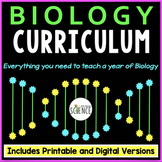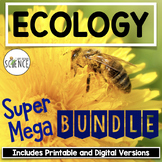Biomes PowerPoint and Notes
- Zip
- Google Apps™

What educators are saying
Also included in
- This NO PREP, PRINTABLE, EDITABLE, AND DIGITAL Biology Curriculum contains everything you need for an entire year of Biology! For less than $3 a day, you can save your time, energy, and sanity. Each of the 20 Complete Units includes a teaching PowerPoint presentation, notes, labs, homework assignmenPrice $525.00Original Price $988.18Save $463.18
- This "Biomes and Aquatic Ecosystems Complete Unit Bundle" includes everything you need to teach a unit on terrestrial biomes and aquatic ecosystems to your life science or biology students. The bundle contains a 94-slide PowerPoint presentation, lecture notes for the teacher, a guided notes outlinePrice $33.99Original Price $44.73Save $10.74
- All of my ecology and environmental science resources (6 ecology unit bundles) are included in this one Super-Mega-Bundle! This mega-bundle includes all of the PowerPoints, notes, labs, task cards, homework assignments, review games, quizzes, activities, and unit tests that you need to teach a compPrice $178.00Original Price $252.64Save $74.64
Description
This colorful and engaging PowerPoint presentation, "Biomes of the World and Aquatic Ecosystems", will provide your students with interactive lessons on the ecological principles concerning terrestrial biomes and aquatic ecosystems. Choose to use the traditional printable version, or the paperless, digital Google Apps version. Your students will learn the major characteristics of each biome as well as the representative plants and animals of each biome. This is a 94-slide PowerPoint presentation and includes a set of lecture notes for the teacher (8 pages)and a note-taking outline for the students (12 pages).
This resource is perfect for traditional classroom settings, distance learning, or for students in 1:1 classrooms.
Click this link to view all of my Digital Resources.
What is included in this product?
- A 94-Slide PowerPoint Presentation (Includes traditional PowerPoint, PDF, and Google slides)
- Editable and printable 8-page set of lecture notes for the teacher
- Editable and printable 12-page guided notes outline for the student
- Paperless Digital Version (not editable) for use in Google Drive, Google Classroom, and /or Microsoft OneDrive
This resource covers 8 major terrestrial biomes as well as aquatic ecosystems. Below you will see a detailed list of topics and concepts that are covered in this PowerPoint Presentation.
Ecology is one of the "must-teach" topics for any biology or life science class. What would a good biology class be without a strong unit (or units!) in Ecology? This colorful and visually appealing PowerPoint may be just what you need to spice up your ecology lessons. Our students are the decision makers of tomorrow. It is imperative that we give them the ecological knowledge (global warming, greenhouse effect, habitat destruction) they need so that they can make informed decisions about our future.
This PowerPoint is called "Biomes of the World". It consists of 94 slides that are colorful, informative and visually stimulating. Pictures and diagrams are included that will greatly enhance your instruction to your students. Graphics, diagrams, clip art, and photographs were chosen to capture the attention of the student as the lesson is being taught. Students will use the outline as the PowerPoint is being presented and will fill in the notes as the lesson is being taught. I always include both the Word document and a pdf of the notes.
Topics covered in this lesson are:
- Biomes: Definition of biome, adaptations of organisms to a biome, tolerance levels of organisms.
- Overview of the major terrestrial biomes: tundra, taiga, chaparral, temperate deciduous forest, temperate grasslands, deserts, savannas, tropical rain forest, biomes map showing locations.
- Tundra: Definition, location, major characteristics, common plants, common animals, loads and loads of photos.
- Taiga: Definition, location, major characteristics, common plants, common animals, loads and loads of photos.
- Chaparral: Definition, location, major characteristics, common plants, common animals, loads and loads of photos.
- Temperate Deciduous Forest: Definition, location, major characteristics, common plants, common animals, loads and loads of photos.
- Temperate Grasslands: Definition, location, major characteristics, common plants, common animals, loads and loads of photos.
- Deserts: Definition, location, major characteristics, common plants, common animals, loads and loads of photos.
- Savannas: Definition, location, major characteristics, common plants, common animals, loads and loads of photos.
- Tropical Rain Forests: Definition, location, major characteristics, common plants, common animals, loads and loads of photos.
- Aquatic Ecosystems: The importance of marine ecosystems to life on Earth, how aquatic ecosystems are determined, the abiotic factors of aquatic ecosystems.
- Ocean Zones: Photic zones, aphotic zones, intertidal zone, neritic zone, oceanic zone, benthic zone, hydrothermal vents, estuaries.
- Students will label a diagram of the different ocean zones.
- Upwellings, phytoplankton, zooplankton, productivity levels in each zone, species richness.
- Freshwater zones: Characteristics of freshwater zones, flowing-water ecosystems, standing-water ecosystems, eutrophic lakes, oligotrophic lakes, wetlands, bogs, marshes, swamps.
Related products include:
Terrestrial Biomes and Aquatic Ecosystems Task Cards
Biomes and Aquatic Ecosystems Homework and Study Guides
Terrestrial Biomes Card Sort Game
Aquatic Ecosystems Domino Review Game
Introduction to Ecology PowerPoint with Notes for Teacher and Student
Population Ecology PowerPoint with Notes for Teacher and Student
Food Chains and Food Webs Activity
Community Ecology PowerPoint with Notes for Teacher and Student
Energy Flow and the Recycling of Matter PowerPoint with Notes for Teacher and Student
Human Impact on the Environment PowerPoint and Notes
FREE Set of Six Ecology Crossword Puzzles
FREE! Backyard Ecology: An Ecological Assessment of Your Back Yard
Biomes of the World Review Questions and Answers PowerPoint
Terrestrial Biomes and Aquatic Ecosystems Unit Test
For updates about sales and new products, please follow my store:








